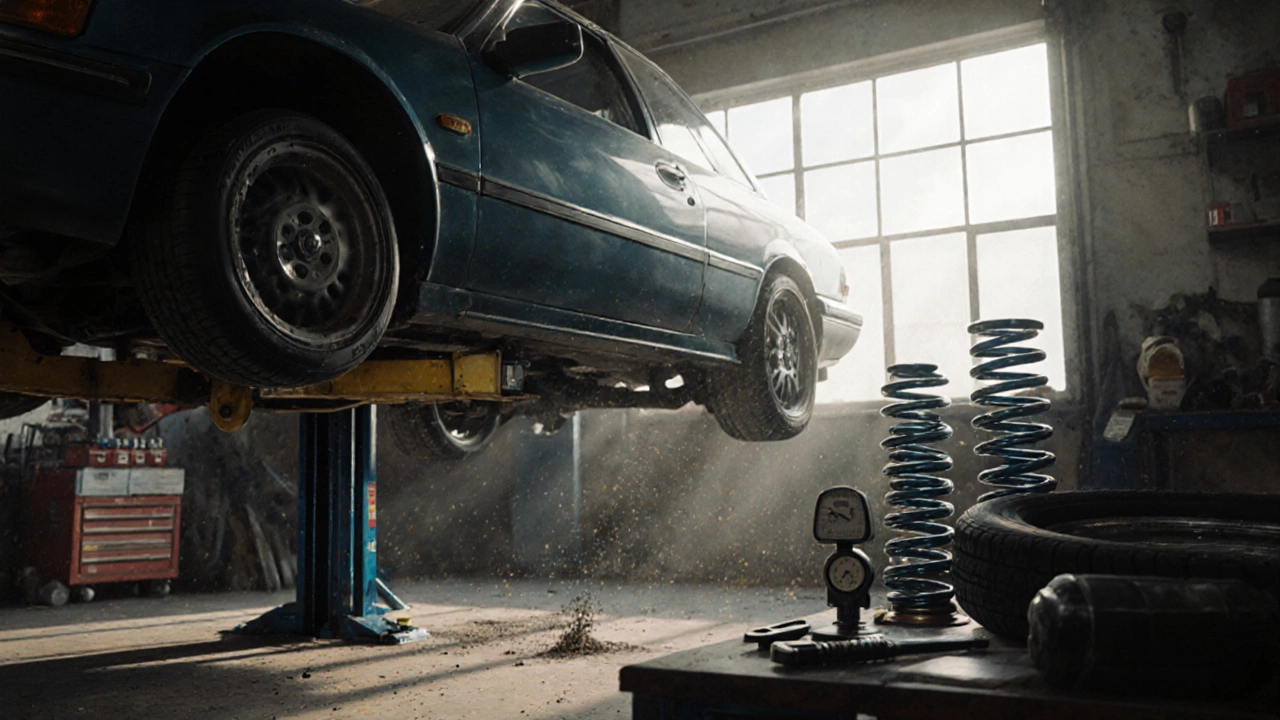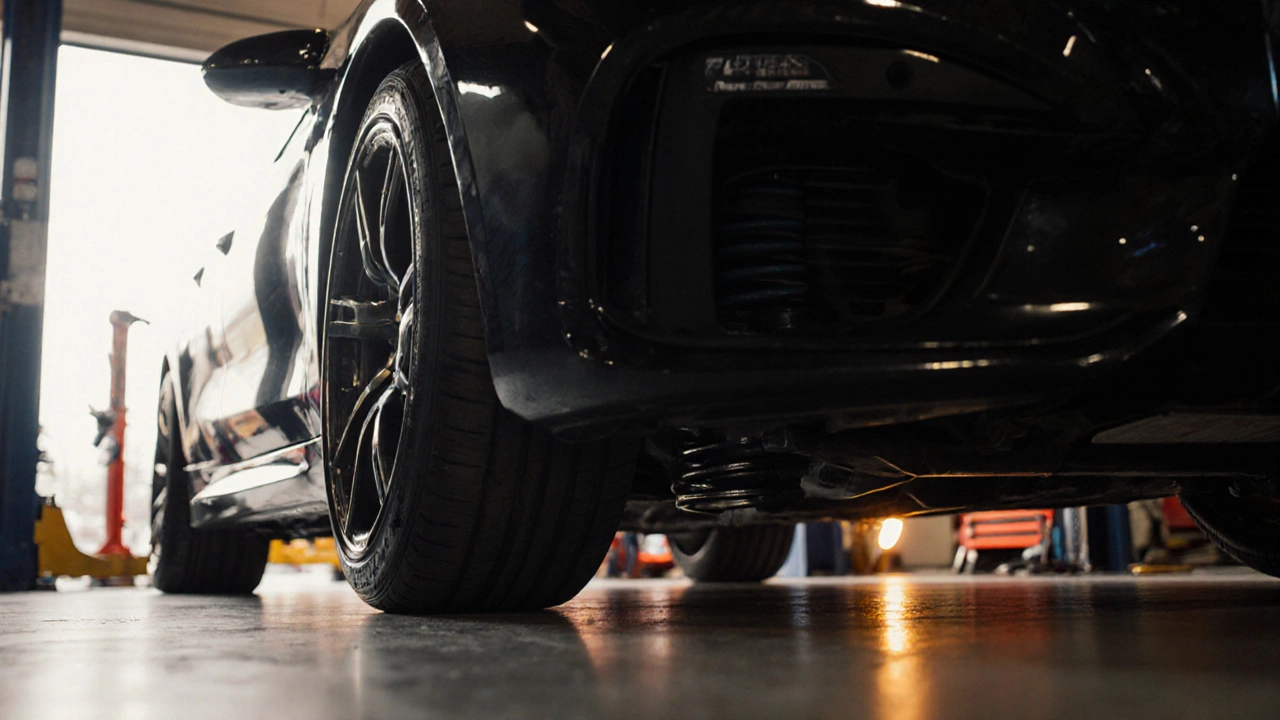Ride Height & Handling Impact Calculator
Calculate Your Suspension Impact
Your Suspension Analysis
Lowered CG improves cornering grip but reduces suspension travel
Typical change: 0.5° per 10mm drop. More than 2.5° causes uneven tire wear
Comfort decreases as drop increases. Over 30mm may cause harsh ride
Professional Alignment Required
After installation, your alignment angles will need adjustment to prevent tire wear.
Wondering what actually happens when you drop a car’s stance with lowering springs? The answer isn’t just “it looks cooler.” Changing the spring rate reshapes how the chassis, wheels, and tires interact, which in turn tweaks everything from cornering grip to daily comfort. This guide breaks down each effect, points out common pitfalls, and gives you a road map for a safe, balanced lower‑ed ride.
What are lowering springs?
Lowering springs are a type of coil spring engineered to be shorter and stiffer than a vehicle’s stock springs, thereby reducing ride height while maintaining load‑bearing capacity. They replace the original springs in the front or rear suspension (or both) and are popular among enthusiasts who want a more aggressive look and sharper handling. Because they are a mechanical component, they affect the entire suspension system, not just the visual gap between tire and wheel arch.
How do they change ride height?
Ride height refers to the vertical distance between the vehicle’s chassis and the ground, measured at the wheel arch. When you install lowering springs, the spring’s shorter free length pulls the control arms closer to the chassis, typically dropping the car 10‑30 mm per corner. The exact amount depends on spring design, vehicle weight, and whether you also adjust shock absorber preload. A lower ride height lowers the center of gravity, which is the first reason handling improves.
Impact on handling and cornering
Handling describes how a vehicle responds to driver inputs such as steering, braking, and acceleration. By lowering the center of gravity, the car experiences less body roll during cornering, allowing the tires to stay flatter on the road. This translates to quicker turn‑in, more predictable feel, and often a measurable reduction in lap times for spirited drivers. The stiffer spring rates also reduce suspension deflection, which means the chassis moves less and the tires can maintain a more constant contact patch.

Effect on wheel alignment and camber
Camber is the angle of the wheel relative to vertical when viewed from the front of the car. Lowering the springs changes the suspension geometry, generally adding negative camber (top of the tire tilting inward). While a few degrees of negative camber can boost cornering grip, too much leads to uneven tire wear on the inner edge. After a spring swap, a professional alignment is essential. The alignment process will set camber, caster, and toe to values that match the new ride height while keeping tire wear in check.
Potential downsides: comfort, tire wear, and component stress
Stiffer, shorter springs can make the ride feel harsher over bumps, especially on rough city streets. The reduced suspension travel means the car may bottom out on deep potholes or speed bumps if the shocks aren’t correctly tuned. Additionally, because the springs load the chassis at a steeper angle, you may see increased stress on mounts, bushings, and shock absorbers. If the spring rate is too high for the vehicle’s weight, it can cause premature wear on wheel bearings and even affect braking performance due to altered weight transfer.

Installation tips and compatibility checks
- Verify spring length and rate match the manufacturer’s specifications for your make, model, and intended drop.
- Check that the coil spring seats on the strut or shock are compatible; some cars require new mount plates or revised shock preload collars.
- Consider pairing lowering springs with matched lowering shocks or coil‑over kits for optimal damping.
- After installation, perform a full alignment to correct camber, caster, and toe.
- Inspect for clearance issues with the wheel wells, brake calipers, and suspension links before final tightening.
Quick comparison: stock vs. lowered suspension
| Aspect | Stock Springs | Lowering Springs |
|---|---|---|
| Ride height | Typically 120‑150 mm (front) | Reduced by 10‑30 mm per corner |
| Center of gravity | Higher, more body roll | Lower, less roll |
| Spring rate | Soft‑to‑moderate | Higher (stiffer) |
| Camber change | Factory‑set, neutral to slight | More negative camber (≈‑1.5° to ‑2.5°) |
| Ride comfort | Comfort‑oriented | Harsher on bumps |
| Handling | Predictable, less aggressive | Quicker turn‑in, better grip |
| Potential tire wear | Even wear | Increased inner‑edge wear if alignment off |
Frequently asked questions
Will lowering springs affect my daily driving comfort?
Yes. Because the springs are stiffer and sit lower, bumps feel sharper and you’ll notice more chassis movement on rough roads. Pairing the springs with performance shocks can soften the harshness while keeping the handling benefits.
Do I need a new alignment after installing lowering springs?
A professional alignment is a must. The change in ride height alters camber, caster, and toe, and an alignment will set those angles to values that maintain grip and protect tire life.
Can I mix stock rear springs with lowered front springs?
You can, but it creates an uneven front‑to‑rear balance. The front will feel more responsive while the rear remains softer, which can cause understeer. For a balanced setup, either lower both ends or use a progressive spring package designed for split‑drop applications.
Will lowering springs damage my car’s chassis?
If you choose the correct spring rate for your vehicle’s weight and have the suspension components inspected, there’s no inherent risk to the chassis. Oversized rates can overstress mounts and lead to cracks over time.
Is there a legal limit to how low I can go?
Each jurisdiction has minimum ground‑clearance rules. In Queensland, for example, the underside of the vehicle must not be less than 100 mm from the road surface. Always check local regulations before committing to a drop.
Bottom line: lowering springs do more than just shave off a few centimeters of gap. They reshape the car’s dynamics, improve grip, and give a sportier stance, but they also demand proper alignment, compatible shocks, and an awareness of comfort trade‑offs. Follow the installation checklist, verify clearance, and get a professional alignment, and you’ll enjoy a tighter, more engaging driving experience without unexpected tire wear.






